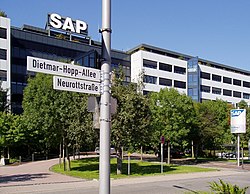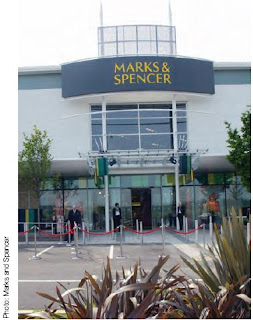SAP Program
SAP AG is a multinational software development and consulting corporation, which provides enterprise software applications and support to businesses of all sizes globally. Headquartered in Walldorf, Germany, with regional offices around the world, SAP is (as of 2009) the largest software enterprise in Europe and the fourth largest software enterprise in the world.The company's best known product is its SAP Enterprise Resource Planning (SAP ERP) software.
As part of the Xerox exit strategy from the computer industry, Xerox retained IBM to migrate their business systems to IBM technology. As part of IBM's compensation for the migration, IBM acquired the SDS/SAPE software, reportedly for a contract credit of $80,000. The SAPE software was given by IBM to the founding ex-IBM employees in exchange for founding stock provided to IBM, reportedly 8%. Imperial Chemical Industries (ICI) was SAP's first ever customer in 1972.[5]
The acronym was later changed to stand for Systeme, Anwendungen und Produkte in der Datenverarbeitung ("Systems, Applications and Products in Data Processing").
In 1976, "SAP GmbH" was founded and the following year, it moved its headquarters to Walldorf. SAP AG became the company's official name after the 2005 annual general meeting (AG is short for Aktiengesellschaft).
In August 1988, SAP GmbH transferred into SAP AG (a corporation by German law), and public trading started November 4. Shares are listed on the Frankfurt and Stuttgart stock exchanges.[4]
In 1995, SAP was included in the German stock index DAX. On 22 September 2003, SAP was included in the Dow Jones STOXX 50.[6] In 1991, Prof. Dr. Henning Kagermann joined the board; Dr. Peter Zencke became a board member in 1993.[7] Claus Heinrich,[8] and Gerhard Oswald [9] have been members of the SAP Executive Board since 1996. Two years later, in 1998, the first change at the helm took place. Dietmar Hopp and Klaus Tschira moved to the supervisory board and Dietmar Hopp was appointed Chairman of the supervisory board. Henning Kagermann was appointed as Co-Chairman and CEO of SAP next to Hasso Plattner. Werner Brandt joined SAP in 2001 as a member of the SAP Executive Board and Chief Financial Officer.[10] Léo Apotheker has been a member of the SAP Executive Board and president of Global Customer Solutions & Operations since 2002, was appointed Deputy CEO in 2007, and then became co-CEO alongside Kagermann in 2008.
Henning Kagermann became the sole CEO of SAP in 2003.[11] In February 2007, his contract was extended until 2009. After continuous disputes over the responsibility of the development organization, Shai Agassi, a member of the executive board who had been named as a potential successor to Kagermann, left the organization.[12] In April 2008, along with the announcement of Leo Apotheker as co-CEO, the SAP supervisory board also appointed to the SAP Executive Board, three new members, effective 1 July 2008: Corporate Officers Erwin Gunst, Bill McDermott and Jim Hagemann Snabe.[13]. With the retirement of Henning in May 2009, Leo has taken over as the sole CEO.
SAP is the world's largest business software company and the third-largest independent software provider in terms of revenues (as of 2007).[16] It operates in three geographic regions – EMEA, which represents Europe, Middle East and Africa; the Americas (SAP America, headquartered in Newtown Square, Pennsylvania), which represents both North America and Latin America; and Asia Pacific Japan (APJ), which represents Japan, Australia, India and parts of Asia. In addition, SAP operates a network of 115 subsidiaries, and has R&D facilities around the globe in Germany, Turkey, Canada, China, Hungary, India, Bulgaria, and North America.
SAP focuses on six industry sectors: process industries, discrete industries, consumer industries, service industries, financial services, and public services.[17] It offers more than 25 industry solution portfolios for large enterprises[18] and more than 550 micro-vertical solutions for midsize companies and small businesses.[19]
SAP ERP is one of five enterprise applications in SAP's Business Suite. The other four applications are:
Other major product offerings include: the NetWeaver platform, Governance, Risk and Compliance (GRC) solutions, Duet (joint offering with Microsoft), Performance Management solutions and RFID. SAP offers SOA capabilities (calling it Enterprise SOA) in the form of web services that are wrapped around its applications.
While its original products were typically used by Fortune 500 companies[citation needed], SAP is now also actively targeting small and medium sized enterprises (SME) with its SAP Business One and SAP Business All-in-One.
On 19 September 2007 SAP announced a new product named SAP Business ByDesign. SAP Business ByDesign is a Software as a Service (SaaS) offering, and provides a fully integrated Enterprise Resource Planning (ERP) solution, On Demand. SAP Business ByDesign was previously known under the code name "A1S".[23] In October 2007 SAP AG announced the friendly merger and acquisition of Business Objects. This acquisition has expanded SAP's Product Suite of Business Intelligence (BI) solutions and expanded the customer installed base to 89,000.(50) (SAP Press releases).
SAP officials say there are over 100,600 SAP installations serving more than 41,200 companies in more than 25 industries in more than 120 countries.[24]
History
SAP was founded in 1972 as Systemanalyse und Programmentwicklung ("System Analysis and Program Development")[3] by five former IBM engineers in Mannheim, Baden-Württemberg (Dietmar Hopp, Hans-Werner Hector, Hasso Plattner, Klaus E. Tschira, and Claus Wellenreuther).[4]As part of the Xerox exit strategy from the computer industry, Xerox retained IBM to migrate their business systems to IBM technology. As part of IBM's compensation for the migration, IBM acquired the SDS/SAPE software, reportedly for a contract credit of $80,000. The SAPE software was given by IBM to the founding ex-IBM employees in exchange for founding stock provided to IBM, reportedly 8%. Imperial Chemical Industries (ICI) was SAP's first ever customer in 1972.[5]
The acronym was later changed to stand for Systeme, Anwendungen und Produkte in der Datenverarbeitung ("Systems, Applications and Products in Data Processing").
In 1976, "SAP GmbH" was founded and the following year, it moved its headquarters to Walldorf. SAP AG became the company's official name after the 2005 annual general meeting (AG is short for Aktiengesellschaft).
In August 1988, SAP GmbH transferred into SAP AG (a corporation by German law), and public trading started November 4. Shares are listed on the Frankfurt and Stuttgart stock exchanges.[4]
In 1995, SAP was included in the German stock index DAX. On 22 September 2003, SAP was included in the Dow Jones STOXX 50.[6] In 1991, Prof. Dr. Henning Kagermann joined the board; Dr. Peter Zencke became a board member in 1993.[7] Claus Heinrich,[8] and Gerhard Oswald [9] have been members of the SAP Executive Board since 1996. Two years later, in 1998, the first change at the helm took place. Dietmar Hopp and Klaus Tschira moved to the supervisory board and Dietmar Hopp was appointed Chairman of the supervisory board. Henning Kagermann was appointed as Co-Chairman and CEO of SAP next to Hasso Plattner. Werner Brandt joined SAP in 2001 as a member of the SAP Executive Board and Chief Financial Officer.[10] Léo Apotheker has been a member of the SAP Executive Board and president of Global Customer Solutions & Operations since 2002, was appointed Deputy CEO in 2007, and then became co-CEO alongside Kagermann in 2008.
Henning Kagermann became the sole CEO of SAP in 2003.[11] In February 2007, his contract was extended until 2009. After continuous disputes over the responsibility of the development organization, Shai Agassi, a member of the executive board who had been named as a potential successor to Kagermann, left the organization.[12] In April 2008, along with the announcement of Leo Apotheker as co-CEO, the SAP supervisory board also appointed to the SAP Executive Board, three new members, effective 1 July 2008: Corporate Officers Erwin Gunst, Bill McDermott and Jim Hagemann Snabe.[13]. With the retirement of Henning in May 2009, Leo has taken over as the sole CEO.
Milestones technical solutions
In 1973, the SAP R/1 solution was launched.[14] Six years later, in 1979, SAP launched SAP R/2.[14] In 1981, SAP brought a completely re-designed solution to market. With the change from R/2 to R/3 in 1992, SAP followed the trend from mainframe computing to client-server architectures. The development of SAP’s internet strategy with mySAP.com redesigned the concept of business processes (integration via Internet).[4] SAP was awarded Industry Week’s Best Managed Companies in 1999.[15] Business and markets
Business and markets
SAP AG Headquarters, Walldorf.
SAP focuses on six industry sectors: process industries, discrete industries, consumer industries, service industries, financial services, and public services.[17] It offers more than 25 industry solution portfolios for large enterprises[18] and more than 550 micro-vertical solutions for midsize companies and small businesses.[19]
Products
SAP's products focus on Enterprise Resource Planning (ERP). The company's main product is SAP ERP. The current version is SAP ERP 6.0 and is part of the SAP Business Suite. Its previous name was called R/3. The "R" of SAP R/3 stood for realtime - even though it is not a realtime solution. The number 3 related to the 3-tier architecture: database, application server and client (SAPgui). R/2, which ran on a Mainframe architecture, was the predecessor of R/3. Before R/2 came System RF, later dubbed R/1.SAP ERP is one of five enterprise applications in SAP's Business Suite. The other four applications are:
- customer relationship management (CRM) - helps companies acquire and retain customers, gain marketing and customer insight
- product lifecycle management (PLM) - helps manufacturers with product-related information
- supply chain management (SCM) - helps companies with the process of resourcing its manufacturing and service processes
- supplier relationship management (SRM) - enables companies to procure from suppliers
Other major product offerings include: the NetWeaver platform, Governance, Risk and Compliance (GRC) solutions, Duet (joint offering with Microsoft), Performance Management solutions and RFID. SAP offers SOA capabilities (calling it Enterprise SOA) in the form of web services that are wrapped around its applications.
While its original products were typically used by Fortune 500 companies[citation needed], SAP is now also actively targeting small and medium sized enterprises (SME) with its SAP Business One and SAP Business All-in-One.
On 19 September 2007 SAP announced a new product named SAP Business ByDesign. SAP Business ByDesign is a Software as a Service (SaaS) offering, and provides a fully integrated Enterprise Resource Planning (ERP) solution, On Demand. SAP Business ByDesign was previously known under the code name "A1S".[23] In October 2007 SAP AG announced the friendly merger and acquisition of Business Objects. This acquisition has expanded SAP's Product Suite of Business Intelligence (BI) solutions and expanded the customer installed base to 89,000.(50) (SAP Press releases).
SAP officials say there are over 100,600 SAP installations serving more than 41,200 companies in more than 25 industries in more than 120 countries.[24]
See also
Reference
http://en.wikipedia.org/wiki/SAP_AG


Comments
Post a Comment